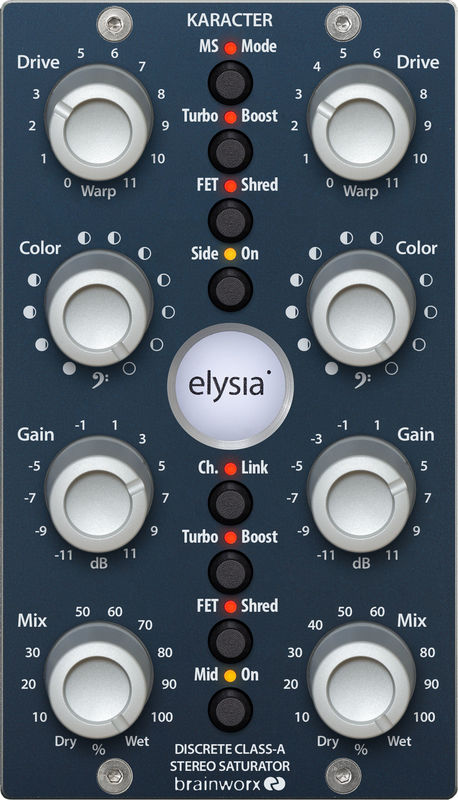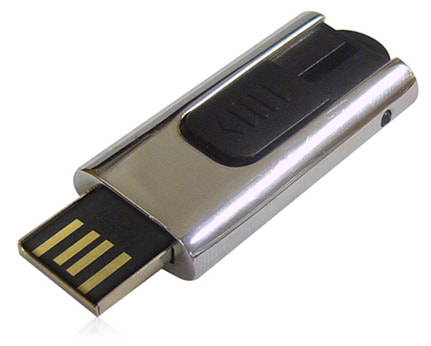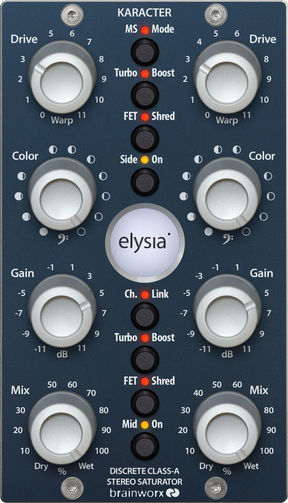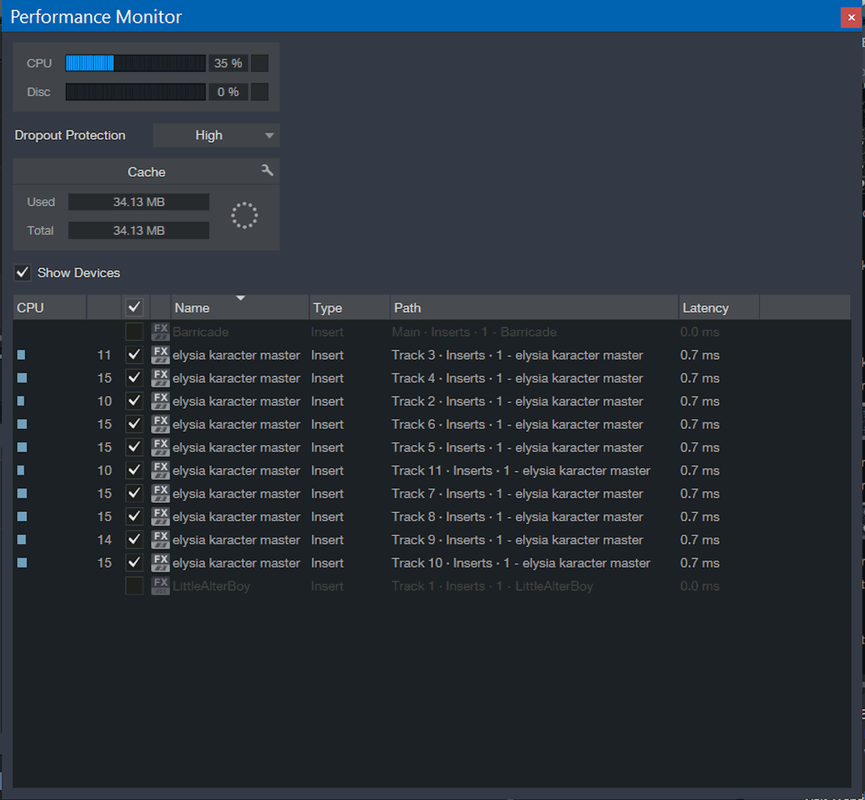Elysia Karacter (Exciting Deep) Review
The question I immediately posed was: “Is this just another ho-hum, hum-drum distortion plug or is the name on its tin aptly deserved?” I’ve been bench-testing Karacter over a period of a few days, comparing it to other Saturation plug-ins that I have on hand, and I’ve concluded that it imparts smooth, controllable harmonic color and character – it does so very nicely indeed.
Karacter is not actually a single plug-in; herein are two iterations of the processor banded together. First, there’s the Mix variant tailored for individual track tasks. Its larger, more feature-laden compadre, Master, is geared towards BUS duties, or even full mix processing. Maybe it’s just my age showing, or perhaps it’s all the time and effort that we engineers have put into trying to “clean” things up, but me thinks that $199 (USD)** is an overly aggressive price point for a Saturation/distortion plug-in. Stick n’ stay – hang out with yours truly for a few minutes, and let’s find out if the steep MSRP price tag is merited. **Excluding Plugin-Alliances special sales and bundle offerings - which by the way, there’s a sale ongoing at the time of this publishing: Get Karacter for $129.
If you’ve been mixing “in-the-box” for any amount of time, there’s no doubt that on occasion, you'd felt as though a track just seemed to lay flat – lifeless, as it were. This could be said of most nearly any drum or instrument track, a vocal track, or even an entire mix. Do you know what I mean? Everything sounded ok, but somehow your mix just seemed to come out somewhat sterile and indistinct. You tried different EQ settings, you swapped out compressors, and heaven forbid, you even drove up some faders – nothing helped.
Enter saturation – the quickest method to inject a convincing degree of analogue-esque mojo into a digital recording. Used judiciously, “Elysia Karacter” sensually caresses your listless, digital tracks with harmonic weight and/or sheen enabling them to come alive - suddenly sounding much bigger and fuller. You might not have realized it, but many of Plugin-Alliance’s products are actually collaborative brainchilds between hardware specialists, such as Elysia or SPL, and DSP software scientists, Brainworx. As per usual, Brainworx’s meticulous attention to detail is in full bloom here. They’ve painstakingly modeled every minuscule detail of the Elysia hardware units, and have coded said details into the virtual digital counterparts.
Installation:
Upon payment, a customer can immediately download the plug-in installer from within their user account area on the Plugin-Alliance web site. Elysia’s Karacter installer weighs in at 60 MB per x86 or x64 apiece. The Mac installer takes up 140 MB. Remember, please, that AAX, VST3 and standard VST formats are all included within each installer. Each plug-in may be fully demoed for a 14-day trial period.
** PLEASE NOTE: Activating PA plug-ins using a standard SD card is doable, but due to Windows OSes sometimes dynamically changing the hardware identifier codes of these kinds of memory devices, activation(s) may not remain permanent. I’ve been in contact with PA tech support about this issue, and I’ve been advised that using a USB flash drive (preferably connected directly, not into a USB hub) is the best practice. One last bit of important intel to know in advance, is that Sandisk brand memory sticks/SD cards ARE NOT supported.
Visual Design:
Karacter plug-in bears the aura of its hardware namesake. Brainworx’s GUI gang has been attentive to mimicking the nuances and uniqueness of the physical rack units’ appearance. Visually-pleasing blue/gray color tones prevent eye fatigue – plus, they look cool. Appropriate spacing between the various GUI appointments, and clearly labeled text elements, make for an uncomplicated, enjoyable user experience. From end-to-end, the interface is neat, clean and intuitive.
As per Plugin Alliance style, along the top of the GUI we’re furnished with a succinct toolbar hosting ‘Undo/Redo’ buttons, a quad grouping of (temporary) preset slots, and polished off with ‘Cut’, ‘Copy’ and ‘Reset’ buttons – these being provided to copy settings from one slot to another for comparative purposes.
Beginning from the left, we’re outfitted with a neat little grouping of three push buttons: On/Off (bypass), ‘FET Shred’ and ‘Turbo Boost’. The lion’s share of the front panel is handsomely occupied by four knobs: Drive, Color, Gain and Dry/Wet - that’s it, that’s all. This minimal compliment of controls keeps everything speedy and simple to dial in.
A tiny niggle that I had concerning GUI functionality on most PA plug-ins, is that by default, the knobs only respond to Circular-relative mouse movements - within “Samplitude Pro X3” and “Mixcraft” specifically. I prefer Linear up/down mouse movements as they tend to be much less fiddly. Howbeit, as I continued to bench-test, Linear mousing *is* the norm within Ableton Live 9, PreSonus StudioOne Pro 3.5 and Reaper 5.
There’s something to be said for clear, well-prepared help documentation. The user’s manual notes that depressing your computer keyboard’s "alt" key alternates the button behavior between circular or linear mousing modes. Speaking of the user's manual, this one is nicely abridged and explains the software's functions very well.
Performance & Functionality:
Let’s start at the top. Undo/Redo buttons come in handy for returning the state of the plug-in’s controls to previous settings, as quickly as possible, without actually fiddling with knobs. Conversely, the opposite is also true – you can redo your plug-in’s disposition. Feel free to copy configurations from one slot to another with the convenient copy/paste menu buttons. It’s nifty that A-B-C-D preset states are also remembered when saving plug-in settings. Mind you, plug-in configuration can only be stored using your DAW’s preset manager since there isn’t one built-in to the Karacter plug-ins themselves. I’d much prefer to have the added convenience of built-in preset management so that plug-in configuration can be more easily transported between DAWs. Common to each of the two variants are Drive, Color, Gain and Dry/Wet controls. Mix and Master Karacter both share the same general feature-set so let’s concentrate on the more generously endowed Master unit. Drive: As one would expect, this knob directly controls the amount of saturation being driven into the processor. Values between 1 – 3 produce lovely, lightly saturated harmonics. These settings are perfectly suited to adding a tinge of sweetness, or fullness, to the audio source. Obviously, as you increase the amount of drive, pronounced distortion ensues and the source gets coated with many shades of ‘color’. In tandem with Turbo Boost (engaged), oodles of wild fuzz-like effects can be experienced. Depressing the FET Shred buttons brings in asymmetrical ‘tube-inspired’ overdrive/distortion, while left in its default "off" position, things remain subtle and symmetrical ** ** Think of the mild, creamy overdrive sounds of an Ibanez Tube Screamer, minus a *mid* bump. Color: Turning this knob counter-clockwise lessens the amount of high frequency content whilst simultaneously buoying the lows and low mids – great for adding warmth and body. Contrariwise, clockwise rotation increases upper mid and high sheen while lightening the bottom end and low mids. In essence, we could consider the ‘Color’ function to be a type of tilt EQ. Centering the knob maintains a flat frequency response. For the most part, I like to keep this dial centered; although I do find that male vocals are enhanced nicely with a slight move to the right - drawing out a little more vocal presence. Gain: I was pleasantly surprised to find out that increasing the amount of ‘Drive’ does not bump up volume – it actually *lowers* volume levels. Much like “makeup gain” on a compressor compensates for volume reduction when applying compression, so too does the 'Gain' control allow an engineer to return an audio signal to unity gain. Thus the Gain knob is very helpful indeed. Dry/Wet: Yeah, baby, you know what this one’s for - easy breezy parallel processing. If you’d like to get zany with distortion and simply bleed some saturation in with the dry signal, it’s entirely doable. No muss, no fuss. No duplicated tracks, nor dedicated aux tracks, required.
MS Mode Switch: Let’s widen the perceived stereo spectrum with harmonically enhanced vibe aplenty. Once M/S Mode is enabled, the left column of controls is dedicated to the mid channel; those on the right manipulating the sides. This is a most welcome process; if, for instance, you’d like to introduce saturation to the center audio elements while keeping the sides completely clean.
On the other hand, if you’d prefer to creatively put some zing or sizzle on the sides, without disturbing the focus and clarity in the center, you’re free to do so. With the gentlest of saturation, your M/S encoded audio material won’t “sound” saturated. Instead, it will just sound widened and more dimensional. Notwithstanding, one could choose to narrow the sonic spectrum of a track, or BUS, if so desired. Turbo Boost: Pretty much self explanatory – a conservative estimation is that the boost increases saturation/distortion by a factor of x2, perhaps more. This, combined with ‘FET Shred’, is a sure fire pathway to achieving overdriven frenzy. FET Shred: In brief, this is like having a factory-installed saturation type mod built-in. Here you can switch between symmetrical or asymmetrical saturation. For the guitarists among us, this can be analogized by a comparison between a (yellow) BOSS SD-1 overdrive pedal and a (green) Ibanez Tube Screamer. A BOSS SD-1 overdrives a signal with even harmonics asymmetrically. The “Tube Screamer” is a symmetrical circuit design, often producing a smoother, creamier saturation (Odd harmonics). Stereo Link: “In this mode, both channels are linked and controlled by just a single set of controls for comfortably processing stereo sources. The left controllers and bottom switches become the master for both channels. The obvious benefit is that you don't have to compare and match the settings of your left and right channels all of the time when processing stereo material. “ – Karacter User’s manual
Sound Quality:
To be very honest, I really like what Karacter does. As a conservative saturator, it’s smooth and velvety. When excessive amounts of Turbo Boosted distortion are inflicted upon unsuspecting tracks, the sound remains controlled and lush. This not to say that the extreme distortion effects that Karacter is capable of are always useful or appropriate; howbeit, they don’t suffer from cheap, aliased garble. Here on the reviewer’s bench, I typically set my audio projects to operate @ 44.1Khz/24bit sampling rates. There are pros and cons to relying on oversampling, but let's not turn this review article into an oversampled vs non-oversampled debate. In a nutshell, here is yours truly’s honest findings: As a general statement, oversampling is NOT necessary for processing clean and undistorted signals within the normal digital audio boundaries of 0dBfs or lower. Heavily saturated and distorted signals GREATLY benefit from oversampling. By classic definition, to distort something is to negatively alter, mangle or disfigure it. In today’s audio-production culture, we generally mean to infer that saturation is the application of increased sustain, harmonics and ‘warmth’ to an audio signal. Of course, there are times when deliberate distortion effects are desirous for creativity’s sake. In these instances, oversampling greatly reduces aliasing and ISPs (inter-sample-peaks). Thus pleasant saturation is resultant - as opposed to grainy, cheap-sounding distortion. With this in view, it’s understandable then, why Brainworx have “hard coded” intelligent oversampling into Karacter. When the plug-in is instantiated in a 44.1 or 48Khz project, it operates at 4x oversampling – the oversampling value is halved when used in a project of 96Khz. Finally, no oversampling is carried out at all for 192Khz (or higher) projects. This accessory well deserves its reputation of being a “coloring box”. At milder, symmetrical saturation settings, Karacter imparts very pleasant, expensive color and vibe. Set more profusely with ‘FET Shred’ engaged, the plug-in takes on a more authoritative posture and definitely brings out some growl. Full blown audio distress is the order of the day once you whack the ‘Turbo Boost’ on. Perhaps not quite as capable of manipulating tone, such as something like FabFilter’s “Saturn” is, the Color knob certainly facilitates super-simple sonic flavoring. Are you finding your synth lead a little too “shrill”? No worries, mate – just twist the ‘Color’ knob counter-clockwise to step-up some warmth while taming the highs. Not hearing enough “oomph” on a kick? Phiff! Not an issue. Roll the color to the left to bolster low & low-mid harmonics, while simultaneously reducing unwanted upper-midrange “click-y-ness”. Optionally, a bass line or rhythm track that isn’t cutting through the mix behooves a ‘Color’ nudge to the right.
CPU & Memory Consumption:
CPU consumption is moderate, if not a little high. I estimate that any average-powered DAW PC, from 2013 and onward, is capable of running a few instances of the Karacter plug-in(s) without too much trouble.
Concluding Remarks:
Elysia Karacter is fast becoming one of my favorite saturation plug-ins. The plug-in is quick and easy to dial in. However, I tend to use as few instances of this component as possible in any single project due to its 4x oversampling (RE: High CPU requirements). Notwithstanding, any track that seems to come out somewhat vanilla, regardless of which ingredients you've added to its FX slots, might well become much more savory once you've flavored it with “Karacter”. The Mastering unit really can work magic on the MAINS or a Stereo-BUS. Width, subtle harmonic enhancement and dimension will dazzle the audio stream like pixie dust did on Cinderella’s slipper. Ok, I’m not sure that was one of my finest creative-writing en fait, but I trust that you get my drift. *Wink. Audio Examples
Stay in the Loop - Subscribe Today!Brother Charles is a freelance writer, Gospel music artist and minister. Charles had been a professional touring musician during the nineties; working primarily as a lead guitarist in the Canadian country music industry. Brother Charles is also involved with music production and quality home recording.
1 Comment
9/8/2020 09:47:38 pm
You can often get it for $29.99 (+Tax) in the Plugin Alliance Sales.
Reply
Your comment will be posted after it is approved.
Leave a Reply. |
NO SPAM! IK Multimedia Group Buy
FX Pick & Mix Group Buy - up to 16 for the price of 1
Will You Help?Web hosting is getting more and more expensive all the time, and Reviewer's Revival is NOT funded nor supported by any commercial enterprise or business. A donation of any amount is greatly appreciated. Even $2 or $3 for a coffee - every little bit helps. Thanks very much.
Legal BlurbAll of the articles published on Reviewer's Revival are undertaken to be purely objective, impartial reviews. Reviewer's Revival is not owned, funded-by, nor hired by any company or individual. Reviewer's Revival is the sole property of, and solely under the discretion and direction of Brother Charles. |










 15% OFF Summer Sale!
15% OFF Summer Sale!
 RSS Feed
RSS Feed

